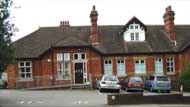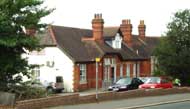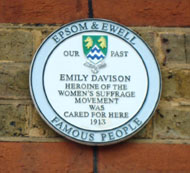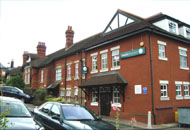Epsom
& Ewell Cottage Hospital
Alexandra Road, Epsom, Surrey K17 4BL
Medical
dates:
Medical
character:
Acute (G.P.)
The Epsom & Ewell Cottage
Hospital opened in 1873 in a house converted for the purpose at
Pembroke Cottages, Pikes Hill, Epsom.
It had 8 beds.
In 1877 the Hospital moved to Hawthorn Place, Epsom.
In 1889 it moved again, to a new Hospital building on a 0.75-acre site in Alexandra Road, Epsom, built to commemorate Queen Victoria's Golden Jubilee. It had 40 beds and was officially opened by Princess Mary, Duchess of Teck.
In 1913 Emily Wilding Davison, a suffragette, threw herself under Anmer, King George V's horse, during the Derby. Anmer turned a complete somersault, throwing his jockey, Herbert Jones. He and Davison were brought to the Hospital for emergency treatment. The jockey had sustained a broken arm and ribs, but Davison died four days later from her injuries. In those days everyone was aware of how easy it was to be fatally injured by a moving horse and, had she survived, Davison would have been charged with 'attempting to cause grievous bodily harm'. Suicide was illegal at that time and brought great shame to the subject's family.
In 1948 the Hospital joined the NHS under the control of the Epsom Group Hospital Management Committee, part of the South West Metropolitan Regional Hospital Board. It became a General Practitioner-run hospital, with its own X-ray Department and Physiotherapy Department.
In 1949 on average 37 of the 40 beds were occupied; patients stayed on average for 18 days.
By 1954 the average bed occupancy was 35 (88%). The weekly cost of an in-patient was £13 15s 3d (£13.76). A single private patient room was charged at £1 19s 0d (£1.95) a day (£13.55 a week), while a pay bed in a double room was charged at £1 17s 0d (£1.85) a day (£12.95 a week).
By 1955 all the beds had had curtain rails and curtains installed, and the wards had a two-way wireless (radio) system. An X-ray Department opened.
In 1959 the Out-Patients Department was extended, the funds for the project having been gifted by the Directors of the Ideal Group of Companies. The new building was opened on 31st March 1960 by Mr L.H.P. Meyer, a successful businessman and Chairman of the Land Development Company (who also gave a further large sum to the Hospital).
In 1959 the Hospital had 81% bed occupancy. The weekly cost of an in-patient was £23 16s 1d (£23.80). The charge for a single private room was £3 9s 0d (£3.45) a day (£24.15 a week) and a bed in a double room £3 6s 0d (£3.30) a day (£23.10 a week).
By 1965 the Hospital had 76% bed occupancy. The averaged weekly cost of an in-patient had risen to £34 9s 6d (£34.47), while a private room cost £5 3s 0d (£5.15) a day (£36.05 a week). A private bed in a double room cost £4 18s 0d (£4.90) a day (£34.30 a week), and an amenity bed £1 4s 0d (£1.20) a day (£8.40 a week).
The Hospital closed in 1988, with 35 beds. Services were transferred to the new 20-bedded Epsom & Ewell Community Hospital which opened in West Park Hospital, Horton Lane, in 1990.
In 1877 the Hospital moved to Hawthorn Place, Epsom.
In 1889 it moved again, to a new Hospital building on a 0.75-acre site in Alexandra Road, Epsom, built to commemorate Queen Victoria's Golden Jubilee. It had 40 beds and was officially opened by Princess Mary, Duchess of Teck.
In 1913 Emily Wilding Davison, a suffragette, threw herself under Anmer, King George V's horse, during the Derby. Anmer turned a complete somersault, throwing his jockey, Herbert Jones. He and Davison were brought to the Hospital for emergency treatment. The jockey had sustained a broken arm and ribs, but Davison died four days later from her injuries. In those days everyone was aware of how easy it was to be fatally injured by a moving horse and, had she survived, Davison would have been charged with 'attempting to cause grievous bodily harm'. Suicide was illegal at that time and brought great shame to the subject's family.
In 1948 the Hospital joined the NHS under the control of the Epsom Group Hospital Management Committee, part of the South West Metropolitan Regional Hospital Board. It became a General Practitioner-run hospital, with its own X-ray Department and Physiotherapy Department.
In 1949 on average 37 of the 40 beds were occupied; patients stayed on average for 18 days.
By 1954 the average bed occupancy was 35 (88%). The weekly cost of an in-patient was £13 15s 3d (£13.76). A single private patient room was charged at £1 19s 0d (£1.95) a day (£13.55 a week), while a pay bed in a double room was charged at £1 17s 0d (£1.85) a day (£12.95 a week).
By 1955 all the beds had had curtain rails and curtains installed, and the wards had a two-way wireless (radio) system. An X-ray Department opened.
In 1959 the Out-Patients Department was extended, the funds for the project having been gifted by the Directors of the Ideal Group of Companies. The new building was opened on 31st March 1960 by Mr L.H.P. Meyer, a successful businessman and Chairman of the Land Development Company (who also gave a further large sum to the Hospital).
In 1959 the Hospital had 81% bed occupancy. The weekly cost of an in-patient was £23 16s 1d (£23.80). The charge for a single private room was £3 9s 0d (£3.45) a day (£24.15 a week) and a bed in a double room £3 6s 0d (£3.30) a day (£23.10 a week).
By 1965 the Hospital had 76% bed occupancy. The averaged weekly cost of an in-patient had risen to £34 9s 6d (£34.47), while a private room cost £5 3s 0d (£5.15) a day (£36.05 a week). A private bed in a double room cost £4 18s 0d (£4.90) a day (£34.30 a week), and an amenity bed £1 4s 0d (£1.20) a day (£8.40 a week).
The Hospital closed in 1988, with 35 beds. Services were transferred to the new 20-bedded Epsom & Ewell Community Hospital which opened in West Park Hospital, Horton Lane, in 1990.
Present
status (July 2008)
The building is still functioning in the health industry; it is now 'The Old Cottage Hospital' and contains a large GP practice, with X-ray and Physiotherapy Departments. In 1994 a Day Surgery Unit opened.


The main frontage along Alexandra Road

The view from the east


The view from the west - the newer extension contains the pharmacy
A plaque on the wall is dedicated to the
suffragette Emily Davison, who died here
Abdy C 2001 Epsom Past. Chichester, Phillimore.
http://query.nytimes.com
www.a2a.org.uk
www.epsom-sthelier.nhs.uk
www.integratedcarepartnership.co.uk
Return to home page